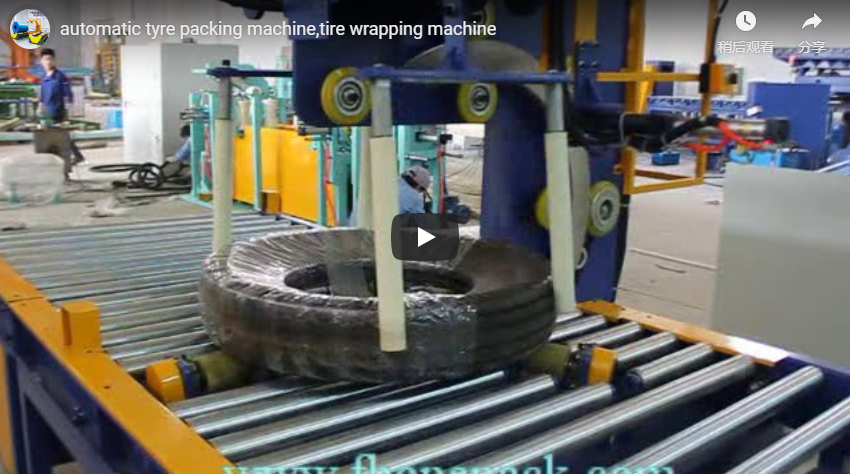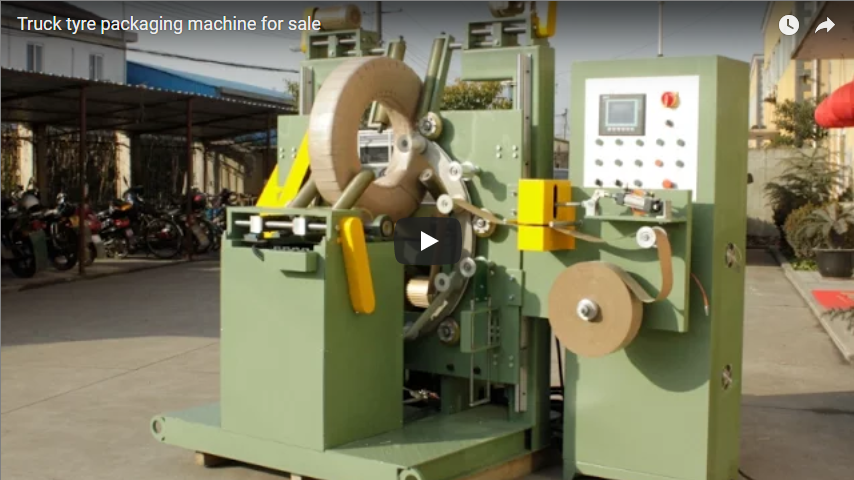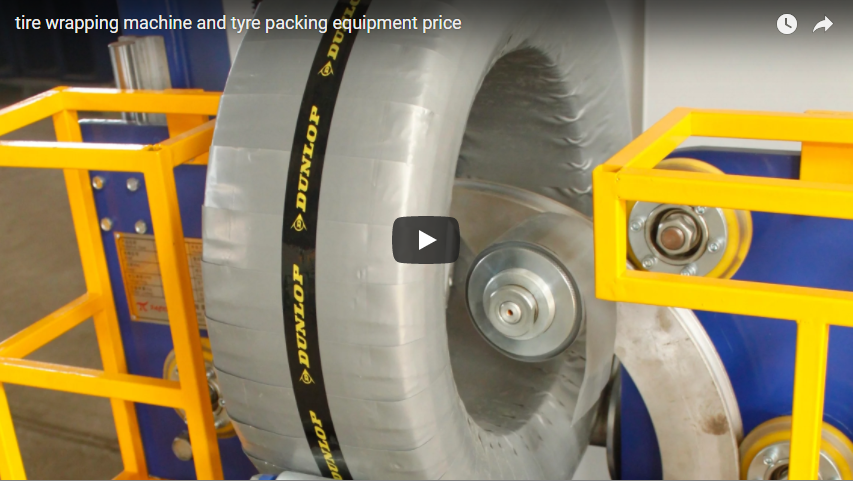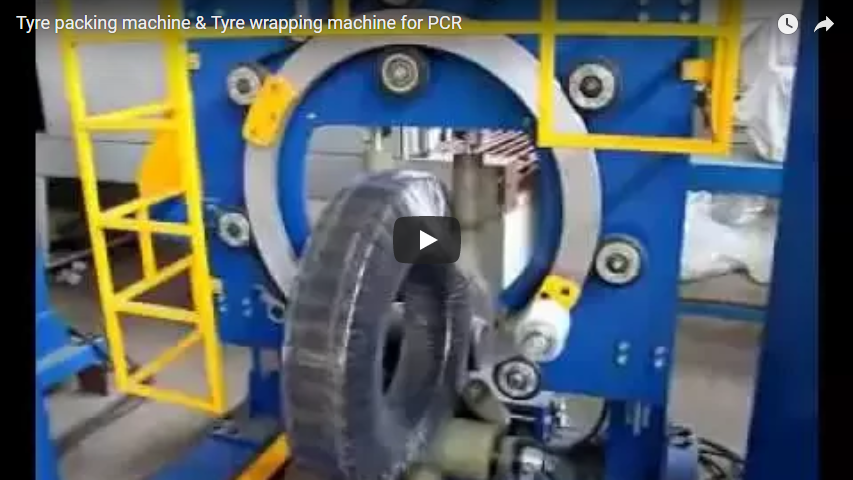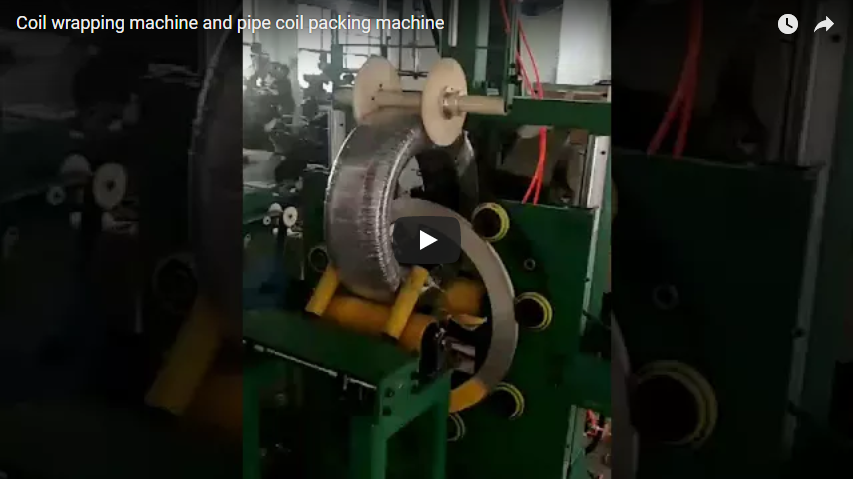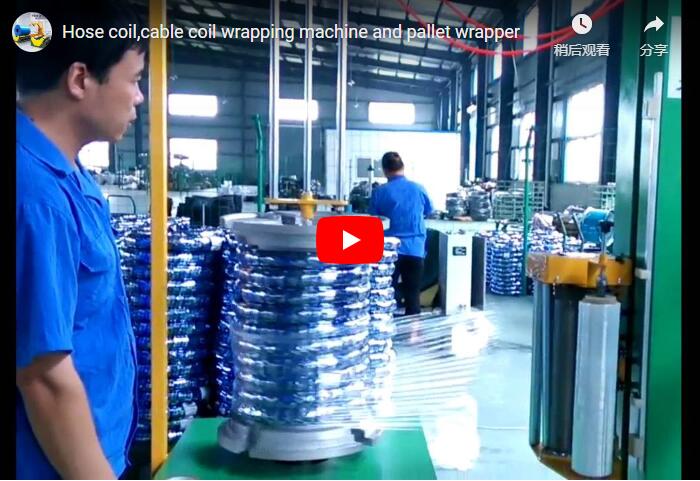Handling and packaging tires efficiently and safely presents a significant challenge in manufacturing plants and distribution centers. Manual processes are often labor-intensive, slow, and carry risks of worker injury and inconsistent package quality. The automated tire wrapping machine, featuring integrated tapping and stacking capabilities as demonstrated in the video above, offers a robust solution to streamline these critical operations, enhancing throughput and reducing operational costs. This system represents a significant step forward in tire logistics automation.
1. Integrated System Overview: From Infeed to Stacked Output
This automated system is engineered to manage the entire tire packaging process seamlessly. Tires typically enter the system via an infeed conveyor. Upon detection, the tire is automatically positioned within the wrapping station. An orbital wrapping mechanism applies stretch film around the tire's circumference. Following the wrap cycle, an automated tapping unit secures the film tail, ensuring package integrity. Finally, the wrapped and secured tire is transferred to a stacking unit, which carefully builds stable, predetermined stacks ready for warehousing or shipment. This integrated approach minimizes manual intervention and optimizes workflow.
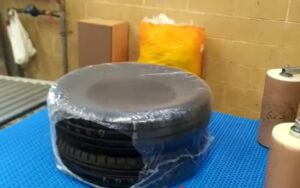
2. Core Components and Advanced Functionality
Understanding the key components reveals the system's sophistication and reliability:
- 2.1 Infeed Conveyor System: Designed for durability and smooth tire transport. Often features sensors for tire detection and positioning, ensuring accurate placement for wrapping. Options may include belt, roller, or chain conveyors depending on specific application needs.
- 2.2 Orbital Wrapping Unit: The heart of the packaging process. Utilizes a rotating ring carrying a stretch film dispenser. Key features include:
- Powered Pre-Stretch: Reduces film consumption significantly (often up to 300%) while improving load containment.
- Adjustable Film Tension Control: Ensures optimal wrapping force for different tire sizes and types without causing distortion.
- Variable Overlap Control: Allows precise programming of film overlap for enhanced protection and stability.
- Automatic Film Cut & Clamp: Streamlines the cycle by automatically managing the film at the start and end of the wrap.
- 2.3 Automated Tapping Unit: Crucial for securing the stretch film tail post-wrapping. This prevents unraveling during handling and storage. Typically employs an adhesive tape applicator synchronized with the wrapping cycle completion.
- 2.4 Stacking Unit: Employs various mechanisms (e.g., pneumatic pusher, robotic arm, lifting platform) to create neat, stable tire stacks.
- Programmable Stack Height: Allows flexibility for different storage or transport requirements.
- Stack Centering & Stability Logic: Ensures stacks are well-formed and safe for subsequent handling.
- Integration with Outfeed: Seamlessly transfers completed stacks to palletizers or exit conveyors.
- 2.5 Central Control System (PLC): Typically features a user-friendly Human-Machine Interface (HMI) touchscreen. Enables operators to:
- Select pre-programmed recipes for different tire sizes/types.
- Monitor system status and diagnostics.
- Adjust parameters like wrapping speed, tension, and stack height.
- Integrate with plant-level control systems (MES/ERP) via protocols like EtherNet/IP or PROFINET.
3. Key Technical Specifications & Performance Data
While specific models vary, typical performance parameters for such automated systems include:
| Parameter | Typical Specification Range | Notes |
|---|---|---|
| Applicable Tire OD | 500 - 1200 mm (20" - 47") | Customizable range often available |
| Applicable Tire Width | 100 - 500 mm (4" - 20") | Dependent on machine configuration |
| Wrapping Speed | 40 - 90+ Tires/Hour | Varies with tire size and wrap parameters |
| Max. Stacking Height | 1500 - 2500 mm (59" - 98") | Limited by stability and safety factors |
| Stretch Film Width | 76mm (3") / 125mm (5") / 250mm (10") | Depends on wrapping unit design |
| Film Pre-Stretch Ratio | Up to 300% | Significant film savings potential |
| Control System | PLC with HMI Touchscreen | Standard industrial automation platform |
| Power Supply | 380V/480V, 3-Phase, 50/60Hz | Check manufacturer specifics |
| Compressed Air Requirement | 6-8 Bar (90-115 PSI) | For pneumatic actuators (if used) |
| Machine Footprint | Varies greatly by configuration | Requires dedicated floor space |
Note: These are representative figures. Always consult manufacturer documentation for precise specifications.
4. Robust Design and Structural Integrity
Built for demanding industrial environments, these machines typically feature:
- Heavy-Duty Steel Frame: Provides stability and longevity, minimizing vibration during operation.
- Precision Machined Components: Ensures reliable operation of rotating rings, conveyors, and actuators.
- Safety Guarding: Comprehensive physical barriers and light curtains protect personnel, complying with international safety standards (e.g., ISO 13849).
- Emergency Stop Circuitry: Strategically placed E-stop buttons for immediate shutdown.
- Accessibility for Maintenance: Designed with consideration for routine checks, lubrication, and component replacement.
5. Quantifiable Operational Advantages and ROI
Implementing an automated tire wrapping and stacking system delivers tangible benefits:
- Increased Throughput: Significantly faster packaging cycle compared to manual methods, boosting overall line efficiency.
- Labor Cost Reduction: Frees up personnel previously engaged in manual wrapping and stacking for higher-value tasks.
- Improved Package Quality: Consistent film application and tension ensure better tire protection and stack stability.
- Enhanced Worker Safety: Eliminates ergonomic risks associated with repetitive lifting and manual wrapping.
- Reduced Film Consumption: Powered pre-stretch technology optimizes film usage, leading to material cost savings.
- Optimized Floor Space: Integrated system often requires less overall space than separate manual stations.
- Data Logging & Traceability: Control systems can often log production data for quality control and process optimization.
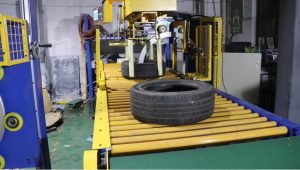
6. System Integration and Customization Potential
These automated systems are designed for flexibility:
- Seamless Line Integration: Easily connects with upstream tire building/curing lines and downstream palletizing or AGV systems.
- Custom Configurations: Can be adapted for specific tire types (PCR, TBR, OTR), sizes, and required throughput rates.
- Optional Add-ons: May include integrated labeling systems, weighing scales, or vision systems for quality inspection.
- Data Interface: Can communicate with higher-level factory management systems for real-time monitoring and control.
[Image Placeholder: Diagram showing the automated tire wrapping process flow]
Alt Text: Diagram illustrating the flow of a tire through the infeed, wrapping, tapping, and stacking stations of the automated system.
7. User Experience and Maintenance Considerations
Modern systems prioritize ease of use and upkeep:
- Intuitive HMI: Touchscreen controls simplify operation, parameter adjustments, and troubleshooting. Pre-set programs minimize setup time for different tire types.
- Simplified Film Loading: Quick-change film carriage designs reduce downtime during roll replenishment.
- Low Maintenance Requirements: Use of high-quality components and sealed bearings minimizes routine maintenance needs. Clear access points facilitate inspections and servicing.
- Remote Diagnostics: Some systems offer remote access capabilities for faster troubleshooting support from the manufacturer.
[Image Placeholder: Close-up of the HMI touchscreen interface]
Alt Text: Close-up view of the Human-Machine Interface (HMI) touchscreen for the automated tire wrapping machine, showing operational controls.
8. Target Industry Applications
This technology is particularly beneficial for:
- Tire Manufacturing Plants: Automating the final packaging stage before warehousing or shipping.
- Automotive OEMs: Handling tires within assembly plant logistics.
- Large Tire Distribution Centers: Processing high volumes of tires efficiently.
- Third-Party Logistics (3PL) Providers: Offering specialized tire handling services.
Conclusion: Driving Efficiency in Tire Handling
The automated tire wrapping machine with integrated tapping and stacking represents a powerful solution for overcoming the challenges of manual tire packaging. By combining speed, consistency, safety, and material efficiency, these systems offer a rapid return on investment through reduced labor costs, increased throughput, and improved product protection. For facilities handling significant tire volumes, investing in this automation technology is a strategic move towards leaner, safer, and more productive operations.
Further Reading & Resources:
- Explore advances in packaging automation at MHI (Material Handling Industry) (External Link)
- Learn about safety standards for industrial machinery from ISO (International Organization for Standardization) (External Link)
- Discover related [Automated Packaging Solutions on our site] (Internal Link Placeholder)
- Read [Case Studies on Automation ROI in Manufacturing] (Internal Link Placeholder)

